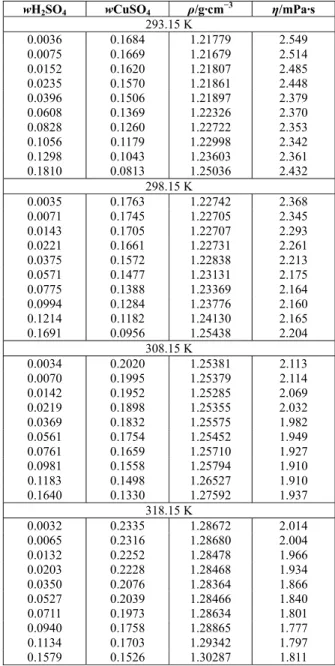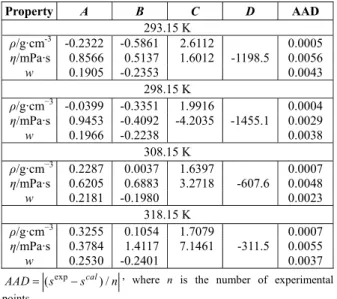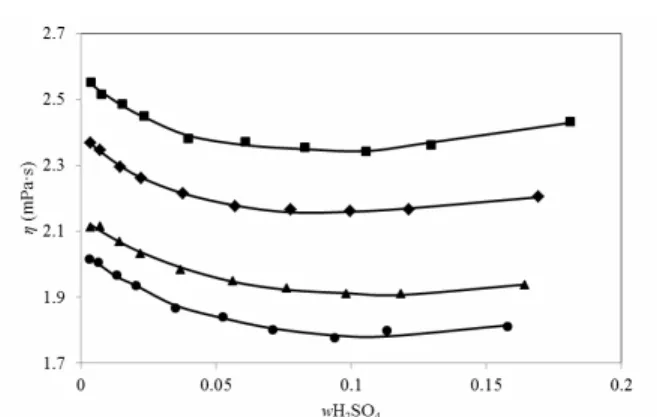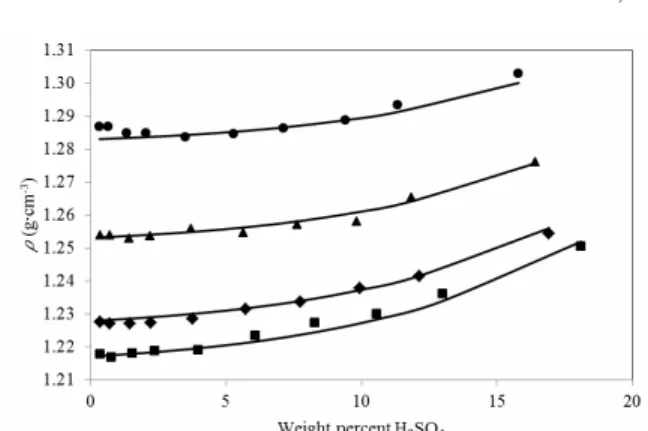ISSN 0104-6632 Printed in Brazil
www.abeq.org.br/bjche
Vol. 32, No. 03, pp. 629 - 635, July - September, 2015 dx.doi.org/10.1590/0104-6632.20150323s00003393
Brazilian Journal
of Chemical
Engineering
SOLUBILITIES AND PHYSICAL PROPERTIES OF
SATURATED SOLUTIONS IN THE COPPER
SULFATE + SULFURIC ACID + SEAWATER
SYSTEM AT DIFFERENT TEMPERATURES
F. J. Justel, M. Claros and M. E. Taboada
*Department of Chemical Engineering, University of Antofagasta, Angamos 601, Antofagasta, Chile. E-mail: franciscajustel@gmail.com; mclaros@uantof.cl
*E-mail: mariaelisa.taboada@uantof.cl
(Submitted: March 28, 2014 ; Revised: September 25, 2014 ; Accepted: September 26, 2014)
Abstract - In Chile, the most important economic activity is mining, concentrated in the north of the country. This is a desert region with limited water resources; therefore, the mining sector requires research and identification of alternative sources of water. One alternative is seawater, which can be a substitute of the limited fresh water resources in the region. This work determines the influence of seawater on the solid−liquid equilibrium for acid solutions of copper sulfate at different temperatures (293.15 to 318.15 K), and its effect on physical properties (density, viscosity, and solubility). Knowledge of these properties and solubility data are useful in the leaching process and in the design of copper sulfate pentahydrate crystallization plants from the leaching process using seawater by means of the addition of sulfuric acid.
Keywords: Seawater; Copper sulfate; Sulfuric acid.
INTRODUCTION
The most important economic activity in Chile is mining. Currently, there is a worldwide shortage of available fresh water. Therefore, mining industries are developing new methods to optimize water use (Torres et al., 2013). In northern Chile, for example, certain mining companies are using raw seawater in their production processes (Rocha et al., 2013) and purified seawater by reverse osmosis (Philippe et al., 2010). In a mining process, the solid−liquid equilib-rium and physical properties of solutions change upon seawater incorporation, especially the density and viscosity; which are used in pipe-sizing and pumping calculations. These properties are related to the cost of energy required to bring seawater to mining operations, usually farther than 120 km (Hernández et al., 2012). Copper sulfate pentahydrate
(Blue vitriol) is a copper salt with a wide range of commercial applications: in agriculture as a pesti-cide, fungipesti-cide, feed, and soil additive (Milligan and Moyer, 1975); in mining, it is used as a floatation reagent in recovery of zinc and lead (De Juan et al., 1999); as a blue and green pigment in dyes, as a print toner in photography, in the production of other cop-per compounds, and in leather tanning (Richardson, 1997).
630 F. J. Justel, M. Claros and M. E. Tabeada
Brazilian Journal of Chemical Engineering
dissolved in fresh water at a temperature of 80 – 90 °C, and then crystallized by cooling to 25 – 30 °C, in order to remove the impurities (Tabilo, 2012).
Copper sulfate in distilled water solutions has been investigated for crystallization, supersaturation, solid-liquid equilibrium, and properties (De Juan et al., 1999; Domic, 2001, and Milligan and Moyer, 1975). In these studies, crystallization conditions of copper sulfate solutions were determined as a func-tion of both temperature and sulfuric acid concentra-tion. In order to optimize the water use, it is interest-ing to investigate the influence of seawater on the copper sulfate crystallization process. In the litera-ture, there is a publication available of the behavior of copper sulfate in a seawater system (Hernández et al., 2012); this paper provides solubilities and physi-cal properties data of CuSO4 in seawater at pH 2. The present work studies the effect of seawater (3.5% salinity) on the solid-liquid equilibrium of copper sulfate in acid solutions at different tempera-tures (from 293.15 K to 318.15 K). This temperature range was chosen because is within the range in which the crystallization process operates. In addi-tion, the physical properties, density, and viscosity of the saturated solution are experimentally measured and correlated with empirical equations, finding a good agreement.
From the results obtained in this investigation, and in order to minimize the use of fresh water, the next step of this work is to perform the copper sul-fate crystallization process from leaching solutions using seawater to study the effect of the ions present in seawater on the habit and size of copper sulfate pentahydrate crystals.
MATERIALS AND METHODS
Reagents
Analytical grade reagents were used (copper (II) sulfate pentahydrate, Merck, 99%; absolute sulfuric acid, Merck, 95 to 97%, absolute). The experiments were performed using filtered natural seawater ob-tained from San Jorge Bay, Antofagasta, Chile. Table 1 shows the composition of the seawater, obtained by chemical analysis, used in this work (Hernández et al., 2012).
Table 1: Individual ions in seawater from Bahía San
Jorge, Chile (mg·L−1).
Na+ Mg+2 Ca+2 K+ B+3 Cu2+ Cl- SO4-2 HCO3- NO3
-9480 1190 386 374 4.6 0.072 18765 2771 142 2.05
Apparatus
The solutions were prepared using an analytical balance (Mettler Toledo Co. model AX204, with 0.07 mg precision). To obtain the phase equilibrium data at different temperatures, a rotary thermostatic bath (to ± 0.1 K, 50 rpm) with a capacity of ten 90 mL glass flasks was used. The densities were measured using a Mettler Toledo DE-50 vibrating tube den-simeter with ± 5·10−2 kg·m−3 precision.
The kinematic viscosities were obtained using a calibrated micro-Ostwald viscometer with a Schott-Gerate automatic measuring unit (model AVS 310), equipped with a thermostat (Schott-Gerate, model CT 52) for temperature regulation. The absolute vis-cosities were calculated by multiplying the kinematic viscosity and the respective density.
Procedures
Equilibrium Time Determination
The equilibrium time was determined at 298.15 K. Acidic seawater was prepared by adding sulfuric acid to seawater and stirring the solution until it reached pH 2; this pH was used because it is similar to the pH levels in copper mining operations. The masses of copper (II) sulfate pentahydrate in the solution (seawater at pH 2) were measured. An ex-cess of copper (II) sulfate pentahydrate was added to ensure saturation of the solution. Several saturated solutions (CuSO4 + acid seawater) were placed in closed glass flasks and immersed in a rotary water bath at 298.15 K, these solutions were mechanically shaken. Every hour, the rotation was stopped, one flask was removed from the bath and, maintaining the work temperature (298.15 K) and using a syringe filter (to ensure that no copper sulfate pentahydrate solid was present in the solution), the solution den-sity was measured. The equilibrium time was deter-mined when the solutions that were taken at different times (every one hour), reached constant densities.
Measurement of Physical Properties in Different Conditions
After the equilibrium time was determined, ten so-lutions (CuSO4 + acid seawater) at different acid con-centrations were prepared.
elevated temperature (to prevent salt precipitation at lower temperatures), the solutions (without solid) were obtained for each equilibrium point.
Physical properties (density and viscosity) were measured in triplicate for each solution. On the other hand, copper (II) concentration was measured in duplicate by atomic absorption and the CuSO4 solu-bility was obtained by stoichiometry.
All measurements of the physical properties and solubilities were performed at four different tempera-tures: 293.15, 298.15, 308.15, and 318.15 K.
RESULTS AND DISCUSSION
Experimental Results
The solubilities, densities, and viscosities are shown in Table 2, for the system studied at different tem-peratures and acid concentrations.
Solubilities
Table 2 shows the solubility results, expressed as mass fraction of copper sulfate (wCuSO4) for differ-ent acid mass fractions (wH2SO4). A significant de-crease in solubility was clearly observed with the increase of sulfuric acid in solution; this behavior was observed for all the temperatures. This behavior of the solubility is due to the common ion effect, because copper sulfate and sulfuric acid share the same SO42- ion (Cisternas, 2009).
Solubility, expressed as a mass fraction, decreases from approximately 0.1684 to 0.0813 at 293.15 K; 0.1763 to 0.0956 at 298.15 K; 0.2020 to 0.1330 at 308.15 K; and 0.2335 to 0.1526 at 318.15 K. These results show that sulfuric acid might be used as an advantageous co-solvent in the crystallization proc-esses design of copper sulfate pentahydrate.
The solubility results of the saturated solution may be correlated with the sulfuric acid composition by the following equation:
0.5 2 = + ×
s A B w (1)
where s is the solubility in mass fraction, w2 repre-sents H2SO4 mass fraction, and A and B are fitting parameters.
Physical Properties
Table 2 presents the densities and viscosities of the saturated solutions for the copper sulfate + seawater + sulfuric acid system.
Table 2: Solubility (wCuSO4), density (ρ), and
viscosity (η) for saturated solutions of copper
sul-fate in seawater at various acid concentrations and temperatures.
wH2SO4 wCuSO4 ρ/g·cm−3 η/mPa·s
293.15 K
0.0036 0.1684 1.21779 2.549 0.0075 0.1669 1.21679 2.514 0.0152 0.1620 1.21807 2.485 0.0235 0.1570 1.21861 2.448 0.0396 0.1506 1.21897 2.379 0.0608 0.1369 1.22326 2.370 0.0828 0.1260 1.22722 2.353 0.1056 0.1179 1.22998 2.342 0.1298 0.1043 1.23603 2.361 0.1810 0.0813 1.25036 2.432
298.15 K
0.0035 0.1763 1.22742 2.368 0.0071 0.1745 1.22705 2.345 0.0143 0.1705 1.22707 2.293 0.0221 0.1661 1.22731 2.261 0.0375 0.1572 1.22838 2.213 0.0571 0.1477 1.23131 2.175 0.0775 0.1388 1.23369 2.164 0.0994 0.1284 1.23776 2.160 0.1214 0.1182 1.24130 2.165 0.1691 0.0956 1.25438 2.204
308.15 K
0.0034 0.2020 1.25381 2.113 0.0070 0.1995 1.25379 2.114 0.0142 0.1952 1.25285 2.069 0.0219 0.1898 1.25355 2.032 0.0369 0.1832 1.25575 1.982 0.0561 0.1754 1.25452 1.949 0.0761 0.1659 1.25710 1.927 0.0981 0.1558 1.25794 1.910 0.1183 0.1498 1.26527 1.910 0.1640 0.1330 1.27592 1.937
318.15 K
0.0032 0.2335 1.28672 2.014 0.0065 0.2316 1.28680 2.004 0.0132 0.2252 1.28478 1.966 0.0203 0.2228 1.28468 1.934 0.0350 0.2076 1.28364 1.866 0.0527 0.2039 1.28466 1.840 0.0711 0.1973 1.28634 1.801 0.0940 0.1758 1.28865 1.777 0.1134 0.1703 1.29342 1.797 0.1579 0.1526 1.30287 1.811
The values for density and viscosity were correlated as a function of copper sulfate and sulfuric acid com-position following Equations (2) and (3), respectively:
(
0.5 2.5)
1 1 2
exp ln
= A+ ×B w w + ×C w
ρ (2)
(
2.5 2.5 3.5)
1 2 2 1
exp
= A+B w× + ×C w + ×D w ×w
η (3)
632 F. J. Justel, M. Claros and M. E. Tabeada
Brazilian Journal of Chemical Engineering
and D are fitting parameters. The units for density and viscosity used in these equations are g·cm−3 and mPa·s, respectively.
The parameter values were obtained by means of the least squares method, for all experimental data, and are shown in Table 3.The absolute average de-viations (AAD) for the fitted parameters are also presented.
Table 3: Parameters values for density, viscosity and solubility for saturated copper sulfate in acidic seawater system.
Property A B C D AAD
293.15 K
ρ/g·cm-3 -0.2322 -0.5861 2.6112 0.0005
η/mPa·s 0.8566 0.5137 1.6012 -1198.5 0.0056
w 0.1905 -0.2353 0.0043 298.15 K
ρ/g·cm−3 -0.0399 -0.3351 1.9916 0.0004
η/mPa·s 0.9453 -0.4092 -4.2035 -1455.1 0.0029
w 0.1966 -0.2238 0.0038 308.15 K
ρ/g·cm−3 0.2287 0.0037 1.6397 0.0007
η/mPa·s 0.6205 0.6883 3.2718 -607.6 0.0048
w 0.2181 -0.1980 0.0023 318.15 K
ρ/g·cm−3 0.3255 0.1054 1.7079 0.0007
η/mPa·s 0.3784 1.4117 7.1461 -311.5 0.0055
w 0.2530 -0.2401 0.0037
exp
( ) /
= − cal
AAD s s n, where n is the number of experimental points.
The results show that these equations fit satisfac-torily the density, viscosity, and solubility experi-mental data.
The solubility of copper sulfate in acidic seawater with different concentrations of sulfuric acid and physical properties of the saturated solutions, at four different temperatures (293.15, 298.15, 308.15, and 318.15 K) are shown in Figures 1 to 3, along with correlated data.
It is possible to note that, for all the temperatures, the solubility decreases with increasing acid concen-tration. Also, the figure shows that solubility levels increased with temperature; this is because, as the solution temperature increases, the average kinetic energy of the molecules that make up the solution also increases. This increase allows the solvent molecules to break apart the solute molecules more effectively that are held together by intermolecular attractions.
Figure 2 compares the density of saturated so-lutions of copper sulfate in acid seawater at four different temperatures (293.15, 298.15, 308.15, and 318.15 K).
Figure 1: Solubility for the saturated solutions
(CuSO4 + acid seawater): ■, 293.15; ♦, 298.15 K; ▲, 308.15 K; ●, 318.15 K; ─, correlations with Eq. (1).
Figure 2: Density for the saturated solutions (CuSO4
+ acid seawater): ■, 293.15 K; ♦, 298.15 K; ▲, 308.15 K; ●, 318.15 K; ─, correlations with Eq. (2).
As can be seen, there is a slight decrease in the density of the solutions at low acid concentrations. However, at a certain point, it begins to increase. This behavior is better observed at higher tempera-tures (at low temperatempera-tures this decrease is not clear). This phenomenon could be attributed, at low acid concentrations, to the copper sulfate solubility de-crease, and therefore, the density; however, as the acid concentration increases, the solution density be-gins to increase, due to the high density of the sulfu-ric acid.
Figure 2 shows that the density values increased slightly with temperature.
Figure 3 compares the viscosity of saturated so-lutions of copper sulfate in acid seawater at four different temperatures (293.15, 298.15, 308.15, and 318.15 K).
Hernández, Hotlos and Price (Hotlos and Jaskula, 1988; Price and Davenport, 1980; Hernández et al., 2012).
Figure 3: Viscosity for the saturated solutions
(CuSO4 + acid seawater): ■, 293.15 K; ♦, 298.15 K;
▲, 308.15 K; ●, 318.15 K; ─, correlations with Eq. (3).
These results confirmed the good fit between ex-perimental values for concentrations of the salt and the physical properties of the saturated solutions at four temperature levels, in a broad range of acid concentrations.
On the other hand, looking for a single equation that includes the effect of different temperatures, we used the empirical models proposed in the work of Milligan (Milligan and Moyer, 1975); to estimate the density and solubility of the system CuSO4 - H2SO4 - H2O at different temperatures (Equations (4) and (5)). The parameters of these equations were ad-justed in acid seawater; for Y0, solubility values of CuSO4·5H2O in fresh water from the literature (Linke and Seidell, 1965) were utilized.
The proposed equations are shown below:
2 2 2(( 2) 2)
2
1
ln⎡ + ⎤
= ⎣ C A + C a X B ⎦
e e
C
ρ (4)
1 0 1 1 1 1 1
( ) ( ) )
1
1
1
ln⎡ ⋅ + ⋅ + ⎤
= ⎣ C A X Y − C A X B + C B ⎦
Y e e e
C (5)
where:
Y= mass percentage of CuSO4·5H2O in saturated solution
ρ
= density of saturated solution in g·cm-3X = mass percentage of H2SO4 in solution
T= temperature in °C 0.01316 0=20.37 T
Y e = mass percentage of CuSO4·5H2O in saturated solution with no acid content
1
( ) 1= − 1
b T
A a e (6)
1 1 1
( )( ) 1 1 1
−
− −
⎡ ⎤ = ⎣ + d T e ⎦
B C e (7)
1 2 1 1 1 1( 1)
− ⎡ ⎤ = ⎣ + − ⎦
C f g T h (8)
( 2) 2
( ) 2= 2
d
c T
A b e (9)
2= 2+ 2 T
B e f (10)
1 2 2 2 1 2( 2)
− ⎡ ⎤ = ⎣ + − ⎦
C g h T i (11)
The parameter values are shown in Table 4. The absolute average deviations (AAD) for the fitted parameters are also presented.
Table 4: Parameter values for density and solu-bility for saturated copper sulfate in acidic sea-water system.
Property Parameters Temperature AAD
a1 0.1165
b1 0.0943 293.15 K 0.2222
c1 21.7293
d1 0.0931 298.15 K 0.3287
e1 30.6388
f1 16.7409 308.15 K 0.2861
g1 2.0939 Solubility
h1 15.0081 318.15 K 0.4501
a2 0.0094
b2 1.187 293.15 K 0.0008
c2 0.00017
d2 1.5986 298.15 K 0.0005
e2 0.9897
f2 0.00162 308.15 K 0.0011
g2 15.51
h2 0.00038 Density
i2 34.16
318.15 K 0.0014
exp
( ) /
= − cal
AAD s s n, where n is the number of experimental points.
In Figures 4 and 5, the density and solubility values of saturated solutions of copper sulfate in acid sea-water at four different temperatures (293.15, 298.15, 308.15, and 318.15 K), and the correlations with the Equations (4) and (5) can be seen.
The experimental values for density, and solubility in the saturated solutions were correlated adequately using Equations (4) and (5) shown previously.
634 F. J. Justel, M. Claros and M. E. Tabeada
Brazilian Journal of Chemical Engineering
Figure 4: Density for the saturated solutions (CuSO4
+ acid seawater): ■, 293.15 K; ♦, 298.15 K; ▲, 308.15 K; ●, 318.15 K; ─, correlations with Eq. (4) (Milligan and Moyer, 1975).
Figure 5: Solubility for the saturated solutions
(CuSO4 + acid seawater): ■, 293.15; ♦, 298.15 K; ▲, 308.15 K; ●, 318.15 K; ─, correlations with Eq. (5) (Milligan and Moyer, 1975).
Figure 6: Solubility for the saturated solutions
(CuSO4 + acid seawater): ■, 293.15; ♦, 298.15 K; ▲, 308.15 K; ●, 318.15 K. Black lines show fresh water data at different temperatures (Milligan and Moyer, 1975).
It is possible to note that the solubility of copper sulfate pentahydrate in seawater is lower than the
solubility of this salt in fresh water. This phenome-non is due to the presence of salts in seawater, which contribute to decrease the solubility of copper sul-fate. This is because the water activity of seawater is lower than the water activity of fresh water and therefore the solubility is lower. Furthermore, as mentioned in Table 1, seawater composition presents 2771 mg·L-1 of SO42- ion, which could be responsible of the decrease in the copper sulfate solubility in this medium, due to the common ion effect. This can be the reason why the average deviation is higher with this equation with respect to the equation proposed in this work.
CONCLUSIONS
With increasing temperature and acid concentra-tion, an increase is observed in the density of the solutions, and there is a slight decrease in the density of the solutions at low acid concentrations.
With increasing acid concentration and tempera-ture, there is a decrease in the solution viscosity.
With increasing acid concentration, there is a de-crease in the solubility; on the other hand, when the temperature increases, the solubility increases.
The experimental values for density, viscosity, and solubility in the saturated solutions, were ade-quately correlated using Equations (1) to (3) proposed in this work, with absolute average deviations for density, viscosity, and solubility of 0.0005, 0.0056, and, 0.0043, respectively, at 293.15 K; 0.0004, 0.0029 and, 0.0038, respectively, at 298.15 K; 0.0007, 0.0048, and 0.0023, respectively, at 308.15 K; and 0.0007, 0.0055, and 0.0037, respectively, at 318.15 K.
The experimental values for density, and solubility in the saturated solutions were correlated adequately using Equations (4) and (5), with absolute average deviations for density, and solubility of 0.0008, and 0.2222, respectively, at 293.15 K; 0.0005, and 0.3287, respectively, at 298.15 K; 0.0011, and 0.2861, spectively, at 308.15 K; and 0.0014, and 0.4501, re-spectively, at 318.15 K.
The solubility of copper sulfate pentahydrate in seawater is lower than the solubility in fresh water due to the presence of salts in seawater, which con-tribute to decrease the solubility of copper sulfate.
ACKNOWLEDGMENT
REFERENCES
Cisternas, L., Diagramas de fases y su aplicación. Reverte (2009). (In Spanish).
De Juan, D., Meseguer, V. and Lozano, L., Una contri-bución al estudio de la solubilidad del CuSO4·5H2O en medio acuoso. Revista de Metalurgia, 35, 47-52 (1999). (In Spanish).
Domic, E., Hidrometalurgia: Fundamentos, Procesos y Aplicaciones. Chile, Andros Impresos (2001). (In Spanish).
Hernández, P., Galleguillos, H., Graber, T., Flores, E. and Taboada, M., Effect of seawater on the solu-bility and physicochemical properties of acidic copper sulfate solutions. Journal of Chemical & Engineering Data, 57(9), 2430-2436 (2012). Hotlos, J. and Jaskuła, M., Densities and viscosities
of CuSO4 - H2SO4 - H2O solutions. Hydrometal-lurgy, 21(1), 1-7 (1988).
Linke, W. and Seidell, A., Solubilities of Inorganic and Metal Organic Compounds. American Chemi-cal Society, Washington DC (1965).
Milligan, D. and Moyer, H., Crystallization in the cop-per sulphate - sulphuric acid - water system.
Engi-neering and Mining Journal, 176(10), 85-89 (1975). Philippe, R., Dixon, R. and DalPozzo, S., Seawater
supply options for the mining industry. WIM2010 Proceeding of the Second International Congress on Water Management in the Mining Industry, Santiago, Chile, 13-20 (2010).
Price, D. and Davenport, W., Densities, electrical conductivities and viscosities of CuSO4/H2SO4 solutions in the range of modern electrorefining and electrowinning electrolytes. Metallurgical Transactions, B, 11(1), 159-163 (1980).
Richardson, H., Handbook of Copper Compounds and Applications. CRC Press (1997).
Rocha, O., Claros, M., Graber, T., Flores, E. and Taboada, M., Solid−liquid equilibrium and process design of CuSO4 + NaCl + (H2O or H2SO4/H2O) systems at 298.15 K. Industrial & Engineering Chemistry Research, 52(20), 6803-6811 (2013). Tabilo, F., Proyecto Anico. Thesis, Universidad de
Chile (2012). (In Spanish).



